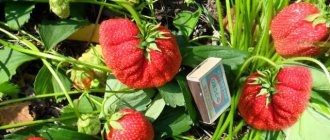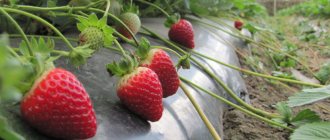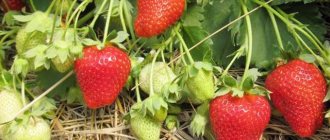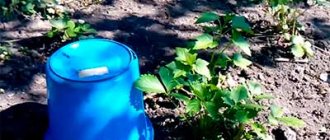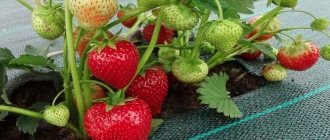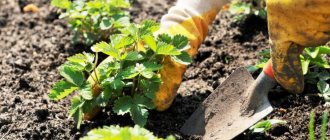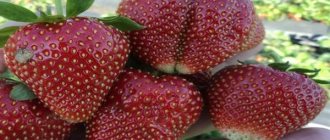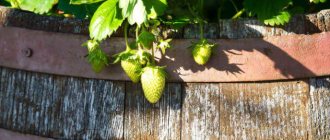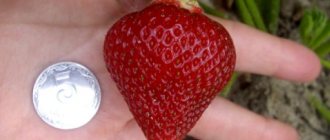Main characteristics
The main distinguishing feature of the culture is its exceptional drought and frost resistance. Description of strawberry variety Elephant:
- Non-repairing variety: fruiting once a year.
- The berry ripening period is average.
- Productivity up to 2.5 kg of berries per bush.
- The berries are large, weighing up to 40 g.
- The color of the fruit and pulp is red, rich and shiny.
- Forms a mustache.
- The bush is erect and powerful.
- Rich aroma of ripe fruits, pronounced classic strawberry sweet and sour taste.
- Resistant to frost and drought.
- The variety has a universal purpose: the berries can be eaten fresh; they are suitable for canning and freezing.
By the end of the season, the berries of the Slonenok variety may become smaller; the variety does not bear stable fruit. Baby Elephant is suitable for personal farming and commercial cultivation; the berries have good transportability.
Description of the variety
Strawberry Baby Elephant is the result of breeding work by scientists at the Siberian Research Institute. It is not surprising that the strength of the variety is its amazing frost resistance. According to the State Register, the Baby Elephant is intended for cultivation in Western and Eastern Siberia. The harvest is formed in the middle stages of ripening.
Bushes
The Elephant's bushes match the name - large, spreading, with a rich leaf apparatus. The plant produces a sufficient number of powerful pale pink tendrils for reproduction. The leaves are concave, somewhat wrinkled, and have a green color with a bluish bloom. The beautiful edging is formed from rounded teeth. Multi-primed thick peduncles are located at the same level with the leaves. During the fruiting period, they lie on the ground under the weight of the harvest. The flowers are bisexual, white or cream in color.
Berries
The shiny, bright red berries are large, ovoid, neckless, often double. Yellow achenes are deeply pressed into the skin. By the end of the season, the fruits become very small. The former can be 30 g or more, the latter can be 8-9 g.
The pulp is red, moderate density, fleshy. There are no voids even in the largest specimens. This strawberry has more pronounced sourness than sweetness, so Slonenok is a variety that is “not for everyone.” But the aroma of the variety is bright, strawberry.
The pulp contains:
- vitamin C - 875.2 mg%;
- sugar - 7.2%;
- acids - 0.8%.
If the summer turns out to be warm, sunny, and you don’t overdo it with watering, the Baby Elephant can be sweet
Productivity
According to the results of state tests, 71.3−87.3 quintals were obtained per hectare. strawberries Baby Elephant. The variety is responsive to intensive agricultural technology, so there are results of more than 100 c/ha. At dachas and in personal gardens, the Elephant Child produces more than 500 g per bush. The fruits can be transported over short distances, but the harvest does not last long - up to 3 days in a cool place.
Garden strawberries Slonenok are universal in use, suitable for preserves, jams, compotes, long-term freezing
Pros and cons of the variety
Despite its unpretentiousness and ability to withstand natural disasters, the Elephant variety has a number of disadvantages:
- The berries are susceptible to gray fruit rot. Excessive rainfall contributes to this disease; the berry harvest can be halved.
- The taste of the fruit is not for everyone - there is sourness in the taste, the pulp of the berries is not juicy and dense enough.
- Possibility of uneven coloring of the fruit: the tip of the berry may remain white.
Baby Elephant is one of the most popular strawberry varieties among gardeners. It has more advantages than disadvantages:
- Large fruit and beautiful appearance of the berry: suitable for decorating desserts.
- Undemanding to agricultural technology.
- Survives and produces decent harvests in areas with variable climates.
- Winter hardiness.
- High yield.
When growing the strawberry variety Slonenok, the main thing is not to overdo it with watering. High humidity is detrimental to fruits. It is recommended to loosen strawberry beds and apply mulching. It is recommended to use pine needles or sawdust as mulch.
Strawberry “Elephant’s Child”: characteristics of the variety and cultivation characteristics
- The ripening period for such plants is average. Their fruiting is one-time (not remontant).
- The bushes of the “Slonenok” variety are erect and powerful. Their conformity is high. The mustache is pale pink in color. The leaf blades on medium-sized seedlings are bright green. The leaves have a slightly concave shape and a slight bluish bloom.
- Each leaf blade has narrow, non-sharp teeth. Strawberry flowers are medium in size, peduncles are the same size. There are a lot of them on each bush (14–18 berries appear on each of them). These bisexual parts are white or slightly cream-colored. The inflorescences on the bushes are semi-spreading and multi-flowered. Leaf formation on the bushes occurs intensively.
- The berries of the “Slonenok” variety are large. The weight of one fruit can reach 30 grams. Each of them is ovoid in shape, although some berries grow in double or comb-like forms. The strawberry has no neck at all.
- The surface of each berry is bright red with a glossy skin. The pulp of such strawberries is also rich red in color. The taste of this variety is sweet and sour. “Slonok” has a pleasant aroma of garden strawberries. Small seeds on the surface of the berry are slightly pressed into the pulp.
- The yield level of such strawberries is high. From just one hectare of land you can get up to 90 centners of fresh berries.
- The fruits of the “Slonenok” variety contain many substances beneficial to the human body. So, in their composition you can find a considerable amount of vitamin C. They also contain various nutritional acids and sugars.
READ MORE: Vietnamese pigs: breeding and keeping piglets at home
You can plant seedlings of the “Elephant’s Baby” variety either in spring or autumn. But still, most gardeners advise planting plants in the autumn, because only at this time of year are all the necessary conditions created for the normal development of such young plants.
For planting, you should select bushes that have at least 3 or 4 young leaves. The root should reach a length of no more than 10 centimeters. If the root system significantly exceeds this value, then it is permissible to prune it a little. First, it is better to leave it for a while in a special composition to stimulate growth and development.
It is recommended to plant strawberries in places where beans, cucumbers or parsley were previously grown. But fruit plants can be planted in such a bed only after a few years.
Be sure to check that the soil for future seedlings is free of Colorado potato beetles and wireworms. Don’t forget to fertilize the soil with ammonium nitrate before planting. This should be done a month before planting.
Planting material for the “Elephant Baby” variety is offered by individual nurseries and private manufacturers
It was submitted for testing in 1989, and in 2006 it was officially included in the State Register of the Russian Federation as approved for cultivation in the East and West Siberian regions. Along with other popular Altai varieties of garden strawberries (“Pervoklassnitsa”, “Solnechnaya Polyanka”, “Anastasia”), “Slonenok” is an intervarietal hybrid obtained by crossing the best foreign and domestic varieties.
The strawberry variety must be suitable for the soil type and climate characteristics of the region where it is planned to grow the berries.
The strawberry variety Slonenok is ready for the tests of cold and drought, suitable for the northern regions of Russia.
Landing
Two weeks after applying fertilizers, you need to dig up the selected places. This is done to a depth of at least 30 centimeters. After this, manure or a mass with humus is added to the soil (15 kilograms of humus per 1 square meter of land). In addition, you should add a little superphosphate and potassium chloride to the soil.
After this, you can start planting strawberry seedlings. It is recommended to do this in the evening or in cloudy weather. The dug holes are thoroughly watered with liquid.
The soil is thoroughly compacted. Then the soil is mulched. This is done using a mixture of peat or humus. Young strawberry seedlings are moisturized.
In order for the baby elephant strawberry to fully grow and develop, it is necessary to carry out certain procedures:
- watering;
- mulching;
- pest and disease control.
Remember that the “Slonok” variety requires a high level of humidity, so watering should be carried out frequently in large volumes. Young plants are watered abundantly 6–7 times a month. Moreover, in this case, the drip irrigation system is considered the most effective.
Mulching
To avoid watering too often, the soil must be loosened and mulched. This procedure is also a preventative measure against the formation of weeds.
Straw or sawdust is used for mulching. It is necessary to remove the layer of mulch from the soil in late autumn. After harvesting, it is completely burned, because such natural material can become a favorable environment for the development of microorganisms harmful to plants.
Coniferous plants are often used for mulching. In this case, the layer does not need to be removed in the fall: it can retain heat in winter. In the spring, such a shelter will allow air to penetrate into the soil.
Most often, harmful microorganisms settle in the upper part of the soil, because there they can develop even at low temperatures. To neutralize the soil and avoid the development of parasites, you should treat with Bordeaux mixture (a solution with copper sulfate). Many gardeners immediately use effective chemicals to control pests. Such substances especially help with fungal diseases.
When controlling pests, it is also permissible to use solutions prepared at home. Thus, the most effective of them is considered to be a decoction with the addition of wood ash (40 grams of wood ash per 10 liters of water). For a better effect, pour a little vegetable oil, vinegar and liquid soap into the resulting liquid. This solution needs to be stirred for a long time. After this, it should turn into a homogeneous mass. They wipe the leaf blades with it and soak the soil.
Strawberry "Elephant" boasts many positive qualities:
- unpretentiousness;
- large fruit size;
- beautiful appearance of berries;
- excellent taste of strawberries;
- good level of frost resistance;
- high yield rates;
- good resistance to drought;
- great berry aroma.
Despite such a rather large list of important advantages, strawberries “Elephant’s Child” also have some disadvantages:
- pulp too dense;
- complete dependence of a good harvest on the amount of mineral fertilizers and fertilizing;
- high susceptibility to rot due to waterlogged soil.
READ MORE: Columnar apple tree President: description of the variety, photos, reviews
Reviews from gardeners
Today you can see a considerable number of positive reviews from gardeners about the “Elephant’s Baby” strawberries. Thus, many have noticed that this variety adapts perfectly even to harsh climatic conditions. Even with severe frosts and heavy rains, the plants still developed normally and produced high yields.
Some gardeners also spoke about the high level of productivity. So, from one strawberry bush you can collect up to 2.5 kilograms of fresh fruit. The berries themselves also deserve positive reviews: they have excellent taste, and their pulp is juicy and dense. Most noted that even after long-term storage in the refrigerator, the berries do not lose their amazing taste and appearance.
Some people said that the fruits of this variety ripen quickly, so they can be harvested earlier. In addition, a full harvest can be obtained already in the first year of planting. At the same time, many have noticed that it is worth removing the tendrils and planting the bushes immediately, without delay. Otherwise, the berries will grow much smaller in size, and their appearance will no longer be so attractive. The bushes, in turn, grow too large, and at the same time they do not spread.
Today you can also find negative reviews about the Elephant variety. So, some gardeners said that the berries are too watery, which significantly spoils their taste. In addition, such strawberries are more likely than other varieties to suffer from gray rot. Because of this, dark spots appear on the fruits. It is difficult to cure plants from this disease.
In the next video you can take a closer look at the strawberry variety “Elephant”.
Growing garden strawberries
The success of obtaining a healthy and abundant strawberry harvest depends on the choice of location and compliance with the rules of planting and caring for plants.
When and where to plant
Strawberry seedlings of the Elephant variety can be planted both in spring and autumn - “before winter”. Planting in the fall is more favorable because the plant has time to form a root system.
See also
Description and characteristics of the Solovushka strawberry variety, growing rulesRead
A good place for strawberry beds is a sunny, unshaded area protected from the wind. The more sunlight the plants receive, the larger the strawberries will grow, the berries will be bright and sweet. The best crop predecessors are cucumbers, legumes and parsley. You cannot plant berries after potatoes - wireworms and the Colorado potato beetle will harm the seedlings.
Acidic soils are not suitable for strawberries, but if there is no choice, it is recommended to add lime to the soil.
Selection of seedlings
Seedlings need to be chosen that are healthy and attractive in appearance. The bush should be spreading, with a dense stem, and have 3-4 formed branches. The color of the leaves should be uniform, without spots.
Important! The optimal root length of a young plant is 7-10 cm. It is recommended to trim the roots if they are longer than the required length.
It is recommended to buy seedlings from trusted suppliers: in specialized nurseries, at thematic exhibitions, or grow them yourself.
Planting scheme
Having chosen the optimal area for planting, you should follow a certain sequence of actions:
- A month before planting seedlings, fertilizers are added to the soil - wood ash and ammonium nitrate.
- After two weeks, the soil is dug up and organic fertilizers are added: manure or humus. Plowing depth is 30 cm. At this stage, superphosphate is added from mineral fertilizers.
- After preparing the soil and applying fertilizers, they proceed to planting seedlings. A distance of 80 cm is maintained between the beds, and 20 cm between the bushes. One seedling is placed in small holes: the roots are carefully straightened and sprinkled with earth, compacting the soil with the palm of your hand.
- Mulching the soil: each planted bush is sprinkled on top with a mixture of peat, sand and humus.
- Water each bush thoroughly.
Planting should be done after sunset or in cloudy weather, so that the active rays of the sun do not burn the immature seedlings.
How and when to plant
Planting of seedlings can occur in autumn or spring. A gardener will be able to accurately determine this, taking into account climate conditions. Of course, it is best to carry out planting activities in the fall, as favorable natural conditions are created for deepening the strawberry rosette into the ground. In just a year you can actually get a rich harvest.
It is best to buy planting material from a nursery or get it from your own garden. Bushes that have 3-4 healthy leaves are suitable for planting.
The root should be 10 cm long. If the length is longer, then the root is cut off. The rhizome should first be immersed in water or a solution to stimulate growth.
Now it’s time to decide on the landing site. It should be well lit and protected from drafts. It’s a good idea to have plants such as beans, parsley, radishes, and cucumbers growing in the garden before this. But beds where asteraceae and ranunculus crops previously grew are not suitable. It is possible to plant strawberries in such a bed only after 4 years.
Now it’s time to determine the acidity level of the soil. To plant seedlings of the Elephant variety, the acidity should be no more than 6 pH, and the groundwater should be no more than 60 cm. Be sure to check whether there are Colorado potato beetles and wireworms in the row. If the selected location meets all the requirements, then it is worth adding ammonium nitrate and Bazudin solution to the ground. Do this 30 days before planting.
After 2 weeks, you can dig up the area to a depth of 30 cm. Add 15 kg of humus or manure, 15 g of potassium chloride and 30 g of superphosphate per 1 m2. If the soil is acidic, then a year before planting, 5 kg of lime is added per 1 m1. But how to plant Dukat strawberries, and what are the features of its cultivation, is described in detail in the article at the link.
Video shows how to plant strawberries:
When all the preparatory activities are over, you can plant the seedlings. This is best done in cloudy weather or in the evening. Water the prepared wells with water. A distance of 0.2 m must be maintained between them. And between the rows the distance will be 0.8 m. Lower the roots vertically and cover them with earth. There should be leaves on the surface. Compact the soil and mulch with peat or humus. How to properly plant Symphony strawberries and what they look like is outlined here.
Subtleties of care
The health of the bush and its productivity will depend on compliance with the rules of care.
Watering
The baby elephant loves moisture very much, but in this parameter it is necessary to observe the measure. This is the main feature of the Siberian variety. Excessive moisture will lead to disease, and lack of moisture will lead to shredding of the fruit.
Plants should be watered once a week, generously, under the bush with warm water. Watering is especially important during the period of fruit ripening: the berries take a lot of energy from the bushes. Lack of moisture during this period can lead to yellowing of leaves and weakening of plant immunity.
Fertilizers
Garden strawberries respond responsively to all types of fertilizers. If the soil for strawberries becomes poor in nutrients, the yield decreases sharply and the berries become smaller.
For planted seedlings in the fall, it is recommended to water the bushes with azophoska in a ratio of 100 g of fertilizer per 10 liters of water. In spring, plants are fed with urea - 50 g per 10 liters of water. But you should not get carried away with fertilizing with this fertilizer; it may provoke increased growth of the foliage of the bushes and fewer berries will be produced.
See also
Description and characteristics of Murano variety strawberries, cultivation and propagationRead
Organic fertilizers in the form of rotted manure and peat are applied at the preparatory stage for planting seedlings. They are dug up along with the soil and placed directly into the dug hole for the plant. To avoid burning the root system with high organic content, it is recommended to add a little sand.
Mulching
Prevention of weed control - mulching. It should be carried out regularly, this will make the soil loose and reduce the amount of watering.
Sawdust, pine needles, straw are excellent materials for mulching strawberry beds. It is recommended to leave the needles for the winter; they will protect the plants from the cold and will not harbor pests.
What kind of care does the Elephant variety require?
A baby elephant requires constant and careful care. First of all, this is necessary to maintain the bushes in a healthy condition and to obtain a high-quality harvest.
Due to the abundant formation of mustaches, the beds grow quickly, which leads to severe crushing of the fruits or their complete disappearance, so the mustaches must be trimmed regularly.
Watering mode
The variety requires regular and abundant watering. It must be carried out using warm water through drip systems.
In order not to over-moisten the soil, it is necessary to use mulch: peat, straw, humus. This will not only retain the right amount of moisture in the soil, but will also prevent the proliferation of weeds and pests.
Feeding
Strawberry bushes need fertilizers, especially for large-fruited varieties. If you do not feed the berries in time, the harvest will be small. Feeding is carried out several times a season: in the fall with organic matter, and in the summer with mineral complexes.
Weeding and loosening the soil
Strawberry bushes need constant loosening. The most favorable moment is after light rain or watering. During the growing season, it is expected to loosen the soil at least 8-10 times. The first loosening is carried out in the spring at the moment when the soil is saturated with fertilizers.
See also
Description and cultivation of strawberries of the Cinderella variety
Read
Mulching
In winter, it is necessary to mulch the bushes with pine needles, which will prevent the roots from freezing, but will also allow the strawberries to breathe during the thaw.
Shelter for the winter
You need to cover strawberries for the winter. This will avoid overcooling of the root system and death of the bushes.
In addition to snow, the following are used: sawdust, dry reeds, spruce branches with the addition of fallen leaves, and hay. In specialized stores you can buy non-woven covering material.
Preventive seasonal treatments
Strawberry Baby Elephant can be susceptible to various diseases and pests:
- White or brown spotting is a fungal disease. Their occurrence can be prevented only through preventive treatment with any fungicide. Treatment is carried out in the spring.
- Black and gray rot - affects fruits. To avoid the appearance of gray rot, it is necessary to avoid excessive watering and carry out preventive treatment with Bordeaux mixture 2-4% in the spring. Infected bushes must be removed from the common garden bed.
- Powdery mildew - affects leaves and berries. As a preventative measure, treatment with colloidal sulfur is carried out in the spring.
- Spider mite - the leaves are covered with cobwebs, after which the greens begin to dry. Treated with Karbofos. The temperature of the solution should not be less than 30 degrees.
Pests and diseases
The strawberry variety Slonenok is resistant to common diseases. Most susceptible to infection with gray rot. Excess moisture should not be allowed in the beds. Chemicals can be used to prevent fungal diseases. As a folk remedy, you can treat the berries with a solution of iodine and brilliant green at the rate of 10 drops of brilliant green and 5 drops of iodine per 10 liters of water.
Strawberry Baby Elephant is weakly affected by insect pests. To combat them, it is enough to use folk remedies, for example, it is recommended to sprinkle the leaves of plants with wood ash: preventing pests and applying mineral fertilizers at the same time.
Strawberry Elephant: description and characteristics of the strawberry variety
Traditional variety, medium ripening, berries 25-35 g, red, aromatic, sweet with sourness
00209558Sapling in a pot V0.5 l
| Was: | 59 rub. |
| Price: | 47 rub. |
| Saving: | 12 rub. ( -20% ) |
Detailed description
Medium ripening variety. The berries are large - up to 25 g, red, shiny, aromatic. The taste is sweet with sourness. Productivity is high. The variety is winter-hardy.
8 May 2021 13:31
Perhaps the seller will put it up for auction again later. Write him.
How and when to plant
Breeding the variety
The strawberry variety Elephant is bred using whiskers. After fruiting during the summer, shoots form on the strawberry bushes, on which rosettes are tied - future strawberry bushes. Strong plants without signs of diseases are selected as mother bushes.
The mustache is cut from the uterine bush with scissors, making an oblique cut. The rooted rosette is dug up and planted in a new place. Mustache trimming should be done in the evening, after sunset.
Harvesting and storage
Strawberries of the Elephant variety are a perishable berry crop. The fruits spoil quickly and produce juice after picking. Rules for preserving the presentation of strawberries of the Elephant variety:
- It is recommended to begin harvesting strawberries the day before the berries are fully ripe.
- You cannot water the bushes before harvesting the fruits - the fruits will soften and instantly release juice.
- There is no need to peel the berries for storage; you can remove the sepals from them; you can leave the stalks.
- The best time to harvest is early morning or late evening.
- Avoid direct sunlight on already picked berries.
Important! When picking strawberries, it is necessary to sort the berries: rotten or spoiled specimens should not fall into the general basket.
It is better to store the harvested crop in wooden boxes or wicker baskets with gaps: the berries must be ventilated. The top of the strawberries is covered with gauze or other soft cloth. It is not recommended to sort and peel strawberries before transporting or storing them. It is better to do this before directly eating the berries.
Baby Elephant is an excellent variety of domestically selected strawberries. It can easily survive the vagaries of the Russian changeable climate and please a novice gardener with a decent harvest. The main thing is to water correctly and maintain the moisture balance in the strawberry beds.
Corn planting and care
After planting, corn requires more careful care than other garden crops. Remove the cover when the foliage touches the glass. Protect from birds and hoe around plants as needed. Cover surface roots with soil—do not remove side shoots. Water during dry weather. Tie to a support if the plants are tall and the area is open.
Shake the tassels at the top of each stem in late June or July to aid pollination. Apply liquid fertilizer when the ears begin to enlarge.
Check for ripeness when the silky fibers at the top of each cob turn brown. Peel back part of the wrapper and squeeze a few grains between your fingernails. The cob is unripe if watery juice appears; it is ready to harvest if the liquid is creamy, and it is overripe if the contents are thick and crumbly.

